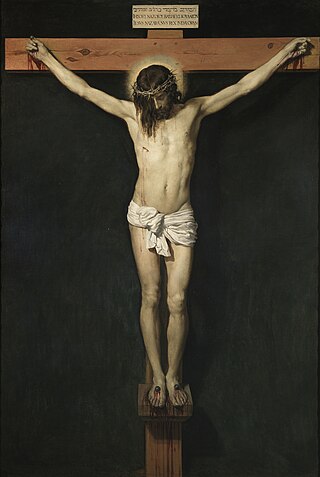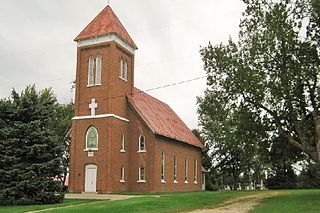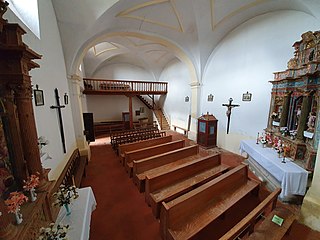
A crucifix is a cross with an image of Jesus on it, as distinct from a bare cross. The representation of Jesus himself on the cross is referred to in English as the corpus.

The Day of the Dead is a holiday traditionally celebrated on November 1 and 2, though other days, such as October 31 or November 6, may be included depending on the locality. It is widely observed in Mexico, where it largely developed, and is also observed in other places, especially by people of Mexican heritage. Although related to the simultaneous Christian remembrances for Hallowtide, it has a much less solemn tone and is portrayed as a holiday of joyful celebration rather than mourning. The multi-day holiday involves family and friends gathering to pay respects and to remember friends and family members who have died. These celebrations can take a humorous tone, as celebrants remember funny events and anecdotes about the departed.

An ossuary is a chest, box, building, well, or site made to serve as the final resting place of human skeletal remains. They are frequently used where burial space is scarce. A body is first buried in a temporary grave, then after some years the skeletal remains are removed and placed in an ossuary. The greatly reduced space taken up by an ossuary means that it is possible to store the remains of many more people in a single tomb than possible in coffins.

Jolly Roger is the traditional English name for the flags flown to identify a pirate ship preceding or during an attack, during the early 18th century.
A skull and crossbones is a symbol consisting of a human skull and two long bones crossed together under or behind the skull. The design originated in the Late Middle Ages as a symbol of death and especially as a memento mori on tombstones.

Auvillars is a commune in the Calvados department in the Normandy region of north-western France.
Symbols of death are the motifs, images and concepts associated with death throughout different cultures, religions and societies.

Totenkopf is the German word for skull. The word is often used to denote a figurative, graphic or sculptural symbol, common in Western culture, consisting of the representation of a human skull- usually frontal, more rarely in profile with or without the mandible. In some cases, other human skeletal parts may be added, often including two crossed long-bones (femurs) depicted below or behind the skull. The human skull is an internationally-used symbol for death, the defiance of death, danger, or the dead, as well as piracy or toxicity.

A headstone, tombstone, or gravestone is a stele or marker, usually stone, that is placed over a grave. It is traditional for burials in the Christian, Jewish, and Muslim religions, among others. In most cases, it has the deceased's name, date of birth, and date of death inscribed on it, along with a personal message, or prayer, but may contain pieces of funerary art, especially details in stone relief. In many parts of Europe, insetting a photograph of the deceased in a frame is very common.

Santa Maria dell'Orazione e Morte is a church in central Rome, Italy. It lies on Via Giulia between the Tiber and the Palazzo Farnese.

The crucifixion of Jesus occurred in 1st-century Judaea, most likely in AD 30 or AD 33. It is described in the four canonical gospels, referred to in the New Testament epistles, attested to by other ancient sources, and is considered an established historical event. There is no consensus among historians on the details.
The skull and crossbones is a symbol of a human skull with two long bones crossed below it. It was historically used on the Jolly Roger pirate flag, and sees modern-day usage as a warning against poison or other deadly hazards.
The skull and crossbones was a common fraternal motif as a symbol of mortality and warning in the late nineteenth and early twentieth centuries. The symbol was adopted, for various reasons, by many sporting teams, clubs, and societies in both America and Europe.

St. Joseph's Catholic Church is a former parish of the Diocese of Davenport. The church is located in Dallas township in rural Marion County, Iowa, United States. It was part of the now defunct village of Bauer. The closest communities are Melcher-Dallas and Lacona. The church building still stands and together with the adjacent cemetery comprises an historic district listed on the National Register of Historic Places.

The Ploudiry Parish close is an enclos paroissial located at Ploudiry within the arrondissement of Brest, Brittany. It comprises a church, ossuary, and calvary. The Parish close was built between the 1630s and 1650s, with major renovations taking place in the 18th and 19th centuries.

The Christian cross, with or without a figure of Christ included, is the main religious symbol of Christianity. A cross with a figure of Christ affixed to it is termed a crucifix and the figure is often referred to as the corpus.

The Iglesia de Santo Domingo de Guzmán it is a Roman Catholic church located in the city of San Cristóbal de La Laguna.

Stradbally is a small village in County Waterford, Ireland.

The Church of Our Lady of the Assumption, is a Catholic church located in Villamelendro de Valdavia, Spain. Originally built in the early twelfth century, the church's architecture is designed in a baroque style.
















